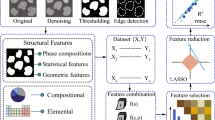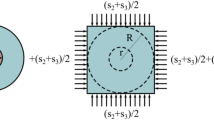Abstract
During last few years, researchers have been concentrating toward the estimation of stress–strain behavior of thin-film coatings using nanoindentation and finite element simulation. In present days, advancement of machine learning algorithms and artificial intelligence made it possible to implement a hybrid approach to extract the properties of a material in a more systematic way. The aim of this work is to find the optimum value of the constants of power-law plastic behavior of thin-film alloy coatings. In this study, an average load–displacement plot was obtained from nanoindentation tests of poly-alloy coatings. Then, a simulation data set was generated in ABAQUS according to design of experiment. A machine learning algorithm was used to generate the surrogate model correlating the constants of power-law plastic behavior as input and mean error between simulation and experimental results as output. Finally, optimization algorithm was used to find out the optimum values of constants of power-law plastic behavior.











Similar content being viewed by others
References
Fischer-Cripps A C, Surf Coat Technol 200 (2006) 4153. https://doi.org/10.1016/j.surfcoat.2005.03.018.
Oliver W C, and Pharr G M, J Mater Res 19 (2004) 3. https://doi.org/10.1557/jmr.2004.19.1.3.
Bouzakis K D, Michailidis N, and Erkens G, Surf Coat Technol 142 (2001) 102. https://doi.org/10.1016/S0257-8972(01)01275-0.
Dao M, Chollacoop N V, Van Vliet K J, Venkatesh T A, and Suresh S, Acta Mater 49 (2001) 3899. https://doi.org/10.1016/S1359-6454(01)00295-6.
Daphalapurkar N P, Wang F, Fu B, Lu H, and Komanduri R, Exp Mech 51 (2011) 719. https://doi.org/10.1007/s11340-010-9373-z.
Kang J J, Becker A A, and Sun W, Int J Mech Sci 62 (2012) 34. https://doi.org/10.1016/j.ijmecsci.2012.05.011.
Yuan Z, Wang C, Li F, Hu Y, Guo Y, Chen Q, Wang Y, and Guo M, Adv Eng Mater 19 (2017) 1700097. https://doi.org/10.1002/adem.201700097.
Goto K, Watanabe I, and Ohmura T, Int J Plast 116 (2019) 81. https://doi.org/10.1016/j.ijplas.2018.12.007.
Bobzin K, Brögelmann T, Brugnara R H, Arghavani M, Yang T S, Chang Y Y, and Chang S Y, Surf Coat Technol 284 (2015) 310. https://doi.org/10.1016/j.surfcoat.2015.07.081.
Hamim S U, and Singh R P, Inverse Probl Sci Eng 25 (2017) 363. https://doi.org/10.1080/17415977.2016.1161036.
Jung J, Yoon J I, Park H K, Kim J Y, and Kim H S, Mater Sci Eng A 743 (2019) 382. https://doi.org/10.1016/j.msea.2018.11.106.
Noii N, and Aghayan I, Int J Mech Sci 152 (2019) 465. https://doi.org/10.1016/j.ijmecsci.2019.01.010.
Moy C K, Bocciarelli M, Ringer S P, and Ranzi G, Mater Sci Eng A 529 (2011) 119. https://doi.org/10.1016/j.msea.2011.09.005.
Li F, Wang J A, and Brigham J C, Comput Geotech 61 (2014) 24. https://doi.org/10.1016/j.compgeo.2014.04.003.
Wang Z L, and Adachi Y, Mater Sci Eng A 744 (2019) 661. https://doi.org/10.1016/j.msea.2018.12.049.
Wang M, Gao L, Cao K, Wu J, and Wang W, Measurement 171 (2021) 108812. https://doi.org/10.1016/j.measurement.2020.108812.
Weng J, Lindvall R, Zhuang K, Ståhl J E, Ding H, and Zhou J, Mech Mater 148 (2020) 103522. https://doi.org/10.1016/j.mechmat.2020.103522.
He G Y, Sun D Y, Zang S L, Chen J, and Fang Z H, Surf Coat Technol 409 (2021) 126855. https://doi.org/10.1016/j.surfcoat.2021.126855.
Chen Z, and Etsion I, Tribol Int 134 (2019) 435. https://doi.org/10.1016/j.triboint.2019.02.025.
Balaraju J N, Rajam K S, Surf Coat Technol 195 (2005) 154. https://doi.org/10.1016/j.surfcoat.2004.07.068.
Balaraju J N, Jahan S M, Anandan C, and Rajam K S, Surf Coat Technol 200 (2006) 4885. https://doi.org/10.1016/j.surfcoat.2005.04.053.
Chen L, Ståhl J E, and Zhou J, J Mater Eng Perform 24 (2015) 4022. https://doi.org/10.1007/s11665-015-1672-1.
Roy S, Mishra B M, and Bose G K, Mater Today Commun 29 (2021) 102991. https://doi.org/10.1016/j.mtcomm.2021.102991.
Shi Z, Feng X, Huang Y, Xiao J, and Hwang K C, Int J Plast 26 (2010) 141. https://doi.org/10.1016/j.ijplas.2009.06.008.
Malik A, Tikhamarine Y, Souag-Gamane D, Kisi O, and Pham Q B, Stoch Environ Res Risk Assess 34 (2020) 1755. https://doi.org/10.1007/s00477-020-01874-1.
Chang C C, and Lin C J, ACM Trans Intell Syst Technol 2 (2011) 1. https://doi.org/10.1145/1961189.1961199.
Karaboga D, An Idea Based on Honey Bee Swarm for Numerical Optimization, vol 200. Technical Report-tr06, Erciyes University, Engineering Faculty, Computer Engineering Department (2005), p 1.
Karaboga D, and Basturk B, J Glob Optim 39 (2007) 459. https://doi.org/10.1007/s10898-007-9149-x.
Karaboga D, and Basturk B, Appl Soft Comput 8 (2008) 687. https://doi.org/10.1016/j.asoc.2007.05.007.
Acknowledgements
This work is financially supported by Council of Scientific and Industrial Research (CSIR-HRDG), Govt. of India, under Sanction No.: 22(0804)/19/EMR-II, dated 25.07.2019
Author information
Authors and Affiliations
Corresponding author
Additional information
Publisher's Note
Springer Nature remains neutral with regard to jurisdictional claims in published maps and institutional affiliations.
Rights and permissions
About this article
Cite this article
Mishra, B.M., Roy, S. A FEM-Supported Hybrid Approach for Determination of Stress–Strain Relation of Poly-alloy Coating by Inverse Analysis. Trans Indian Inst Met 75, 2939–2947 (2022). https://doi.org/10.1007/s12666-022-02674-7
Received:
Accepted:
Published:
Issue Date:
DOI: https://doi.org/10.1007/s12666-022-02674-7




